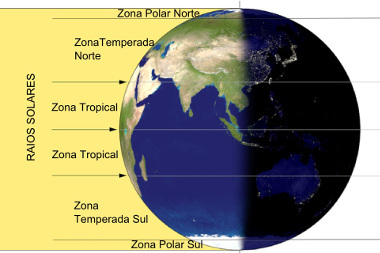At geographic coordinates, as we already know, are the instruments we use to establish the location of any point on the earth's surface. Thus, one of the most important concepts used by coordinates is that of latitude. Shall we remind you?
Latitude is the distance, in degrees, from any point on Earth to the Equator, remembering that this line is imaginary and “cuts” the Earth in half horizontally, dividing the planet into north and south.
Latitudes range from 0º to 90º to the north and from 0º to -90º to the south. Using these numbers in combination with the longitudes, we can thus find any point on the earth's surface.
But what is the relationship between latitude and climate?
The latitudes directly affect the climate, as the sun's rays, responsible for warming our planet, focus on different shapes along the north-south axis, causing the climate to have different conditions as we change the latitudes.
So, we have to: the closer the latitudes get to the Earth's poles, the lower the temperatures. In the same way, the closer the latitudes are to the Equator, the higher the temperatures.
This is because the region that houses the areas that are more or less close to the Equator Line (called the equatorial region) receives a more intense amount of sunlight throughout the year, while the polar regions (closer to the south and north poles) receive less heat from the sun.
Given this, it is even possible to establish some climate zones, which are the latitude ranges in which the climate presents itself in different ways. Check out the following scheme:

Earth's climatic zones explain temperature differences *
We can see, with the figure, that the Tropical Zones tend to be hotter. The Brazilian territory is, almost entirely, located in these ranges, which contributes to the temperature averages in our country being higher than in other places.
On the other hand, the Temperate Zones, during most of the year, have lower temperatures. At certain times, regions in the extreme south of Brazil, for example, present a very strong cold, even snowing in some cases. The Patagonia region in southern Argentina, one of the coldest areas on the continent, is also an example of this.

Patagonia, Argentina, is a very cold area due to its latitude
If these regions are cold, then imagine the Polar Zones! In them are the poles of the earth, the places on the planet where the lowest temperatures are recorded. The extreme north of the American, European and Asian continents suffer from the cold, which makes some locations practically uninhabitable.
Finally, it is important to remember that latitude is not the only factor that affects the climate. There are regions that, even being located in equatorial areas, are cold because of the altitude and numerous other factors.
By Rodolfo Alves Pena
Graduated in Geography
Take the opportunity to check out our video lesson on the subject:


